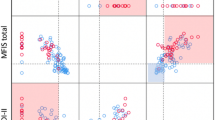Abstract
To determine the value of fatigue in predicting the change in disability status in patients with multiple sclerosis (MS), we realized a prospective population-based cohort study of 196 patients with clinically definite MS. In 2002, baseline data were collected on fatigue (Modified Fatigue Impact Scale), health-related quality of life (SF-36), and disability status (EDSS score). The EDSS scores were determined again at least three years later. Univariate and multivariate analysis were performed to determine the predictive value of different dimensions of fatigue and other variables (depression and SF- 36) on the change in disability status. Of the 196 patients, 106 (54%) patients had an unchanged status or improvement and 90 (46%) showed a worsening of disability. After three years, with control for gender, age, and baseline disability status, a high baseline level of physical fatigue was associated with a worsening of disability status, whereas a low baseline level of physical fatigue was associated with the absence of worsening of the EDSS score. Other dimensions of fatigue, depression and SF-36 were not associated with a worsening of disability.
A patient’s perceived fatigue may be not only a clinically and psychosocially meaningful outcome but also a predictor of objective outcomes such as changes in disability status at three years.
Similar content being viewed by others
References
Bakshi R, Shaikh ZA, Miletich RS, Czarnecki D, Dmochowski J, Henschel K, et al. (2000) Fatigue in multiple sclerosis and its relationship to depression and neurologic disability. Mult Scler 6(3):181–185
Colosimo C, Millefiorini E, Grasso MG, Vinci F, Fiorelli M, Koudriavtseva T, et al. (1995) Fatigue in MS is associated with specific clinical features. Acta Neurol Scand 92(5):353–355
Colosimo C, Riise T, Myhr KM, Nyland HI (1995) Fatigue in MS. Neurology 55(1):51–54
Confavreux C, Compston DA, Hommes OR, McDonald WI, Thompson AJ (1992) EDMUS, a European database for multiple sclerosis. J Neurol Neurosurg Psychiatry 55(8):671–676
Debouverie M, Pittion S, Guillemin F, Vespignani H (2002) [Fatigue scales used in multiple sclerosis]. Rev Neurol (Paris) 158(11):1139–1143
Fatigue Guidelines Development Panel of the Multiple Sclerosis Council for Clinical Practice Guidelines Fatigue and Multiple Sclerosis: evidence-based management strategies for fatigue in multiple sclerosis: 1998
Fisk JD, Pontefract A, Ritvo PG, Archibald CJ, Murray TJ (1994) The impact of fatigue on patients with multiple sclerosis. Can J Neurol Sci 21(1):9–14
Fisk JD, Ritvo PG, Ross L, Haase DA, Marrie TJ, Schlech WF (1994) Measuring the functional impact of fatigue: initial validation of the fatigue impact scale. Clin Infect Dis 18 (Suppl 1):S79–S83
Fisk JD, Doble SE (2002) Construction and validation of a fatigue impact scale for daily administration (D-FIS). Qual Life Res 11(3):263–272
Flachenecker P, Kumpfel T, Kallmann B, Gottschalk M, Grauer O, Rieckmann P, et al. (2002) Fatigue in multiple sclerosis: a comparison of different rating scales and correlation to clinical parameters. Mult Scler 8(6):523–526
Janssens AC, van Doorn PA, de Boer JB, Kalkers NF, van der Meche FG, Passchier J, et al. (2003) Anxiety and depression influence the relation between disability status and quality of life in multiple sclerosis. Mult Scler 9(4):397–403
Kappos L, Weinshenker B, Pozzilli C, Thompson AJ, Dahlke F, Beckmann K, et al. (2004) Interferon beta-1b in secondary progressive MS: a combined analysis of the two trials. Neurology 63(10):1779–1787
Kos D, Kerckhofs E, Carrea I, Verza R, Ramos M, Jansa J (2005) Evaluation of the Modified Fatigue Impact Scale in four different European countries. Mult Scler 11(1):76–80
Kroencke DC, Lynch SG, Denney DR (2000) Fatigue in multiple sclerosis: relationship to depression, disability, and disease pattern. Mult Scler 6(2):131–136
Krupp LB, Christodoulou C (2001) Fatigue in multiple sclerosis. Curr Neurol Neurosci Rep 1(3):294–298
Krupp LB (2003) Fatigue in multiple sclerosis: definition, pathophysiology and treatment. CNS Drugs 17(4):225–234
Kurtzke JF (1983) Rating neurologic impairment in multiple sclerosis: an expanded disability status scale (EDSS). Neurology 33(11):1444–1452
Leplege A, Ecosse E, Verdier A, Perneger TV (1998) The French SF-36 Health Survey: translation, cultural adaptation and preliminary psychometric evaluation. J Clin Epidemiol 51(11):1013–1023
Marrie RA, Fisher E, Miller DM, Lee JC, Rudick RA (2005) Association of fatigue and brain atrophy in multiple sclerosis. J Neurol Sci 228:161–166
Mathiowetz V (2003) Test-retest reliability and convergent validity of the Fatigue Impact Scale for persons with multiple sclerosis. Am J Occup Ther 57(4):389–395
Nortvedt MW, Riise T, Myhr KM, Nyland HI (2000) Quality of life as a predictor for change in disability in MS. Neurology 55(1):51–54
Pittion-Vouyovitch S, Debouverie M, Guillemin F, Vandenberghe N, Anxionnat R, Vespignani H (2006) Fatigue in multiple sclerosis is related to disability, depression and quality of life. J Neurol Sci 243:39–45
Pittock SJ, Mayr WT, McClelland RL, Jorgensen NW, Weigand SD, Noseworthy JH, et al. (2004) Quality of life is favorable for most patients with multiple sclerosis: a population-based cohort study. Arch Neurol 61(5):679–686
Poser CM, Paty DW, Scheinberg L, Mc- Donald WI, Davis FA, Ebers GC, et al. (1983) New diagnostic criteria for multiple sclerosis: guidelines for research protocols. Ann Neurol 13(3):227–231
Visschedijk MA, Uitdehaag BM, Klein M, van der PE, Collette EH, Vleugels L, et al. (2004) Value of health-related quality of life to predict disability course in multiple sclerosis. Neurology 63(11):2046–2050
Author information
Authors and Affiliations
Corresponding author
Rights and permissions
About this article
Cite this article
Debouverie, M., Pittion-Vouyovitch, S., Brissart, H. et al. Physical dimension of fatigue correlated with disability change over time in patients with multiple sclerosis. J Neurol 255, 633–636 (2008). https://doi.org/10.1007/s00415-008-0761-6
Received:
Revised:
Accepted:
Published:
Issue Date:
DOI: https://doi.org/10.1007/s00415-008-0761-6




